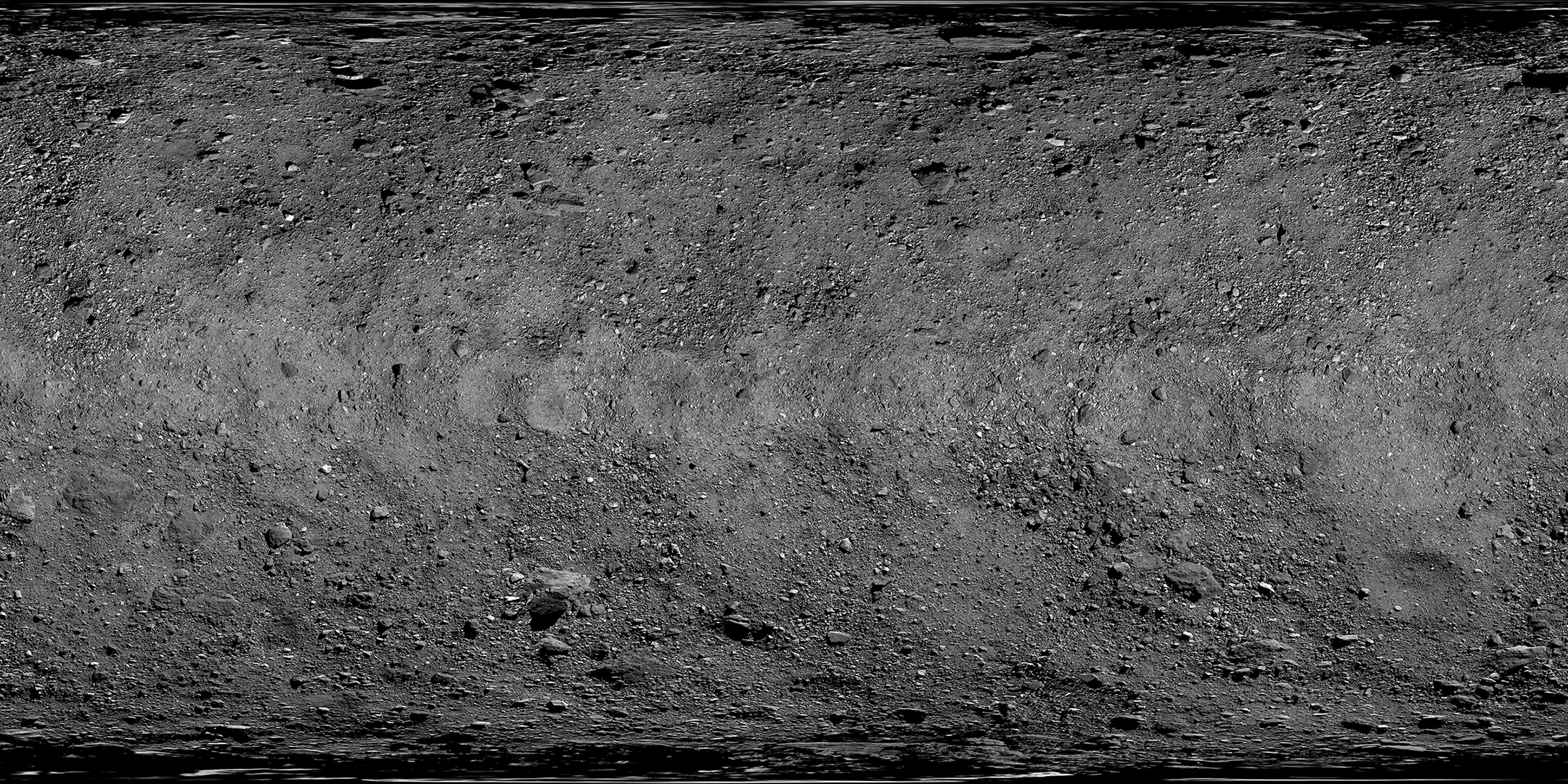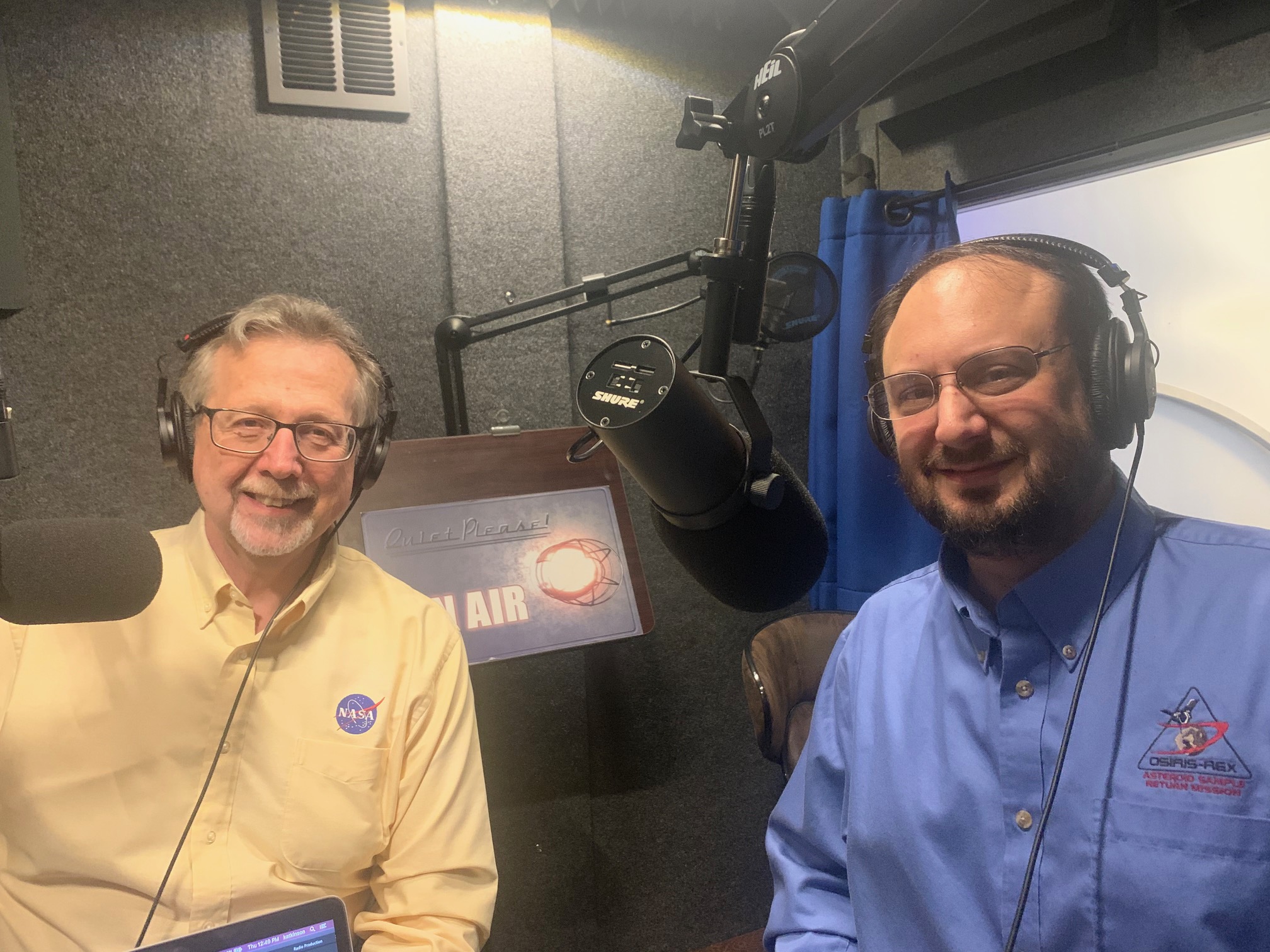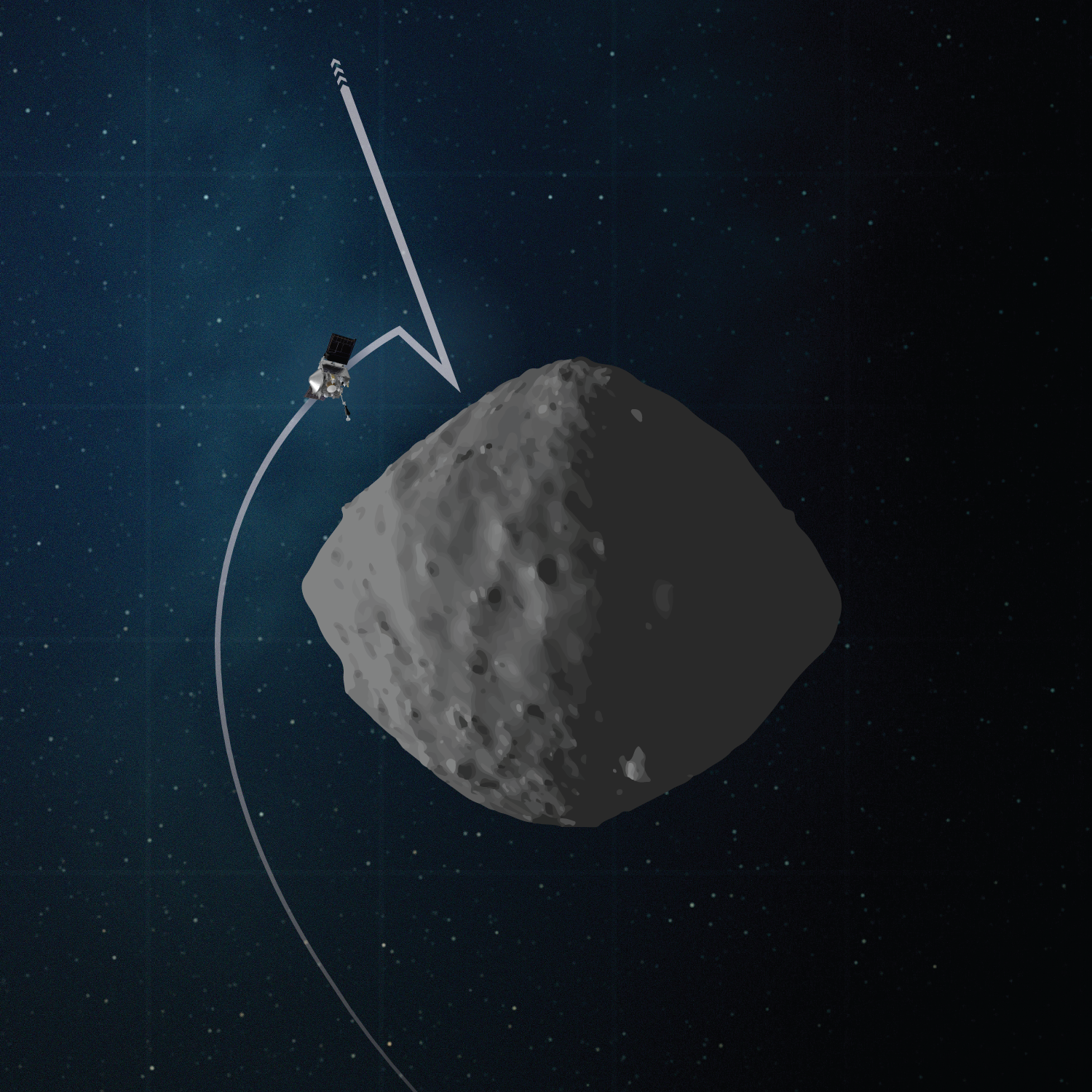
When Earth was just a baby, meteors and asteroids rained down, delivering all sorts of chemicals to our developing planet. These small objects could have delivered the chemicals needed to spark life on Earth for the first time. The OSIRIS-REx mission will collect and return a sample from asteroid Bennu, a 4.5-billion-year-old fossil of the early solar system. By looking at pieces of Bennu in laboratories, scientists will be able to look at its composition and see whether some of the building blocks of life came from objects like Bennu.
Jim Green:How do we know what the early solar system was like?
Jim Green:How does life come from a lifeless beginning?
Jason Dworkin: Bennu is a fragment of the ancient solar system.
Jason Dworkin: We can learn the types of ingredients that were available on the early Earth that could have gone into life, and maybe understand more about ourselves by looking at Bennu.
Jim Green:Hi, I’m Jim Green, chief scientist at NASA, and this “Gravity Assist.” On this season of “Gravity Assist” we’re looking for life beyond Earth.
Jim Green: I’m here with Dr. Jason Dworkin and he is the project scientist for OSIRIS-REx and a research scientist at the Goddard Space Flight Center. Jason’s realm of research is the chemistry of early solar system and the early Earth. Welcome Jason.
Jason Dworkin: Thank you, thank you for having me.
Jim Green: Well you know, how do we know what the early solar system was like and what it had to start with?
Jason Dworkin: The earlier solar system is a period in time that’s a long time ago and is therefore very difficult to understand. We understand the early solar system from looking at spacecraft and ground-based observations with telescopes of our solar system of other star forming regions. We also use our understanding of geology, of the Earth and of other planets to extrapolate what the early Earth would have been like.
Jim Green: But there must have been a spark, something must have happened that changed the chemistry into life as we know it. What do we know about that period and what would have happened?
Jason Dworkin: The so-called spark of the origin of life is a massive question, which has been pursued for decades if not centuries. Understanding how life formed and then subsequently evolved into life as we know it, we can use evidence based on how biology works across organisms today looking at metabolic and genomic factors to understand what life has in common. We can look at the geology of ancient rocks on Earth, to look back and understand what kind of conditions would have been present.
Jason Dworkin: We can look at the formation of the solar system by a number of different means to understand what kind of conditions would have been present. My favorite method of understanding what materials would have been present on the early Earth or early Mars, what have you, is by looking at the rocks that were present at that same time, in the form of meteorites, asteroids and comets. Looking at the same materials that have the same chemistry, the same exposure.
Jim Green: So those things formed in space and became Earth, became terrestrial planets and even bombarded Earth after it came together. Well, where do these meteorites come from?
Jason Dworkin: The meteorites we get on the Earth come from a variety of places, some come from the moon, some came from Mars, some came from asteroid Vesta. The other ones, we don’t really know. We can look at the chemistry and the mineralogy of these rocks and make guesses. Did they come from different kinds of asteroids maybe even comets? There are some that are solid chunks of metal that look like they came from the core of an asteroid, like for example, the mission Psyche will be going to an iron-nickel core of an ancient body, but knowing where a meteorite came from is a current mystery.
Jim Green: So how do we collect these meteorites? Where do we go to get them if they are falling on Earth all the time, how do we differentiate a rock that’s been here on Earth for billions of years and a meteorite that just fell?
Jason Dworkin: Meteorites fall all the time everywhere, everyday. Most of the mass comes in forms of dust, interplanetary dust particles are picked up. For example, high flying airplanes can collect some of these and NASA has a great mission campaign collecting stratospheric dust from space. NASA and NSF [the National Science Foundation] have a joint program that goes to Antarctica every year, as does Japan, to pick up meteorites, which are on the ice. That’s a fantastic place to get meteorites because, well, for one thing, meteorites tend to be black and ice tends to be blue-white, so that makes it easier, but also the Transantarctic Mountains bisect Antarctica and meteorites are carried by ice floes up against these mountains, the ice melts away leaving high concentration meteorites.
Jason Dworkin:Other places like deserts are a good place to find meteorites and they’re a couple cases, two in fact, where an asteroid has been seen in space and then fallen to the ground and been picked up. It was actually, the fireball was imaged as the meteorite was turning from a asteroid into a meteorite.
Jim Green: Yeah, in fact, we have whole teams within NASA that once we alert them that there is something coming in, they get ready to go out and pick up the pieces and bring them to the lab. So it’s a really fascinating opportunity for us to determine how early things in the solar system came together. Well what don’t meteorites tell us?
Jason Dworkin: Meteorites invariably land on the ground and when they do so they become contaminated with biology which is present everywhere.
Jim Green: Earth biology?

Jason Dworkin:Earth biology, yes and understanding the contribution of Earth biology that overprints the organic compounds and other materials from extraterrestrial sources is a massive problem. Furthermore, with very few exceptions we don’t know where meteorites came from. Is this piece of rock from a comet? From the main belt? All kinds of things that we don’t know about just by looking at a rock that has been separated from its parent.
Jim Green: Well so there is one way to get around that, of course, and that is develop a mission and go out and meet them. Now you’re a project scientist on a really exciting mission to an asteroid and it’s there right now and it’s called OSIRIS-REx. Tell us a little more about this fabulous mission.
Jason Dworkin: OSIRIS-REx is an acronym that stands for the purpose of the mission: Origins, Spectral Interpretation, Resource Identification, Security-Regolith Explorer. At asteroid Bennu, it’s orbiting it today, to pick up a sample of rock from the surface, a large sample as these things go. 60 grams is the minimum and the capacity is 2 kilograms, which is a massive amount of sample for scientists to study.
Jim Green: So how long does it take OSIRIS-REx to get to Bennu? It’s got to run it down in the solar system.
Jason Dworkin: So OSIRIS-REx launched, September 8th, 2016, the 50th anniversary of the first episode of Star Trek, flew out around for a year in an Earth gravity assist—nice name—to change planes of the orbits to an inclination of six degrees. Then the following year, finally caught up with Bennu.
Jim Green: And it’s been orbiting it ever since.
Jason Dworkin: The spacecraft has been, has had had two world records, one for the closest orbits, which we then broke with an even closer orbit, and consequently a very slow orbit, also the smallest object ever orbited.
Jim Green: Wow.
Jason Dworkin: We’ll collect the sample bring it back to Earth in 2023, for worldwide analysis.
Jim Green: So what do you think Bennu will tell us about life here on Earth?
Jason Dworkin: Bennu is a fragment of the ancient solar system. By studying this fragment that has not been contaminated by landing on ice and dirt on Earth, been handled with an exquisite chain of evidence, we can learn the types of ingredients that were available on the early Earth that could have gone into life, and maybe understand more about ourselves by looking at Bennu.
Jim Green: So this Bennu it’s as black as coal. I mean the images that are coming back from OSIRIS-REx are really exciting. What can we tell about its shape? How did it get the way it looks?
Jason Dworkin: Bennu is a rubble pile about half-kilometer across. It’s a collection of loose rocks that came from some sort of catastrophic breakup of its original parent body in the asteroid belt. These relaxed to this spinning top shape, this was actually observed on the ground of radar images largely from Arecibo and Goldstone that gave us a really accurate shape model of the asteroid so we knew what we were going after. It gave us the spin rotation, orientation, the length day, all these sorts of great things.
Jim Green: So now you’ve been at Bennu for a while, you’ve studied it in great detail and you’ve picked several sites to consider and now you’ve decided on a particular place on the surface to go after. How did that process go?
Jason Dworkin: One of the things that surprised us about Bennu was how rocky and bouldery it is, in our initial model we figured there would be these large sandy beaches that would make sampling the surface very, very simple. The spacecraft has a 3-meter-long pogo stick with like an old car air filter on the end, not literally an old car air filter. A highly designed piece of machinery that collects sample material by blowing nitrogen gas and collecting it.
Jim Green: Sort of like a vacuum cleaner?
Jason Dworkin: Indeed, the initial name for it was Muucav which is vacuum sort of backwards.
Jim Green: (laughs) Okay.
Jason Dworkin: Because it blows nitrogen gas in the vacuum of space and picks up dust. So we predicted large swarths of sand essentially that we can pick up.
Jason Dworkin: Well it turns out that there are big chunks of rocks, making navigation much more complicated than we had anticipated. Fortunately we have an impeccably well designed spacecraft and a top notch navigation team. So we were able to adjust our strategy to find four potential sampleable locations that we can get material from to bring back to Earth. We went through an extensive process of figuring out which one is the ones we can get to on the spacecraft safely, we can make sure we can navigate to precisely, that have loose regolith and are also the most exciting for science, and of those we found our number one and our number two site, which we’ve named Nightingale and the backup is Osprey, which are names of birds that live in Egypt. Bennu is the name of the asteroid, which is named after an Egyptian bird god.
Jim Green: So Bennu is really fascinating. Now it spins, what is the spin rate?
Jason Dworkin: A day on Bennu is 4.3 hours.

Jim Green: Wow, and you’re going to come to this in a way that then allows you to set down on it and suck up some material. That sounds really challenging.
Jason Dworkin: Yes and no. So it is in principle challenging but we worked for many, many years on developing the technology to make sure that we can do it safely. We only need to touch the surface of Bennu for five seconds, so the spacecraft does a free fall from a low Bennu orbit. Takes about 20 minutes because Bennu is such as small object, we touch the surface and then bounce off at minuscule speeds, a literal snail’s pace, blow the nitrogen gas to collect the rocks and dust and then fire our thrusters and get out.
Jim Green: Yeah, that process is called “touch and go.”
Jim Green: So, one of the surprises then is that you didn’t see dust fields that you were hoping for, and now you see a more of a pebbley field. What are some of the other surprises?
Jason Dworkin: I’d say the most surprising thing that we discovered is that Bennu is ejecting rocks. We had wondered, well, could Bennu be an extinct comet? And so we had a campaign looking for dust plumes. We didn’t see any, but then we saw these surprising couple-centimeter rocks being spat off.
Jim Green: Yeah, like popcorn, just popping off the surface.
Jason Dworkin: Right. And we see this popcorn continuously, not every day, but many days. And we’ve seen particles that are ejected and leave Bennu, some that go into orbit and some that crash back down. Their orbits are stable for, for days.
Jim Green: So what do they think is causing that? The popping going on? Is it the heating of the water that’s in the rocks that then some reaction explodes?
Jason Dworkin: That’s one model, but it’s not totally supported by the data. Another model, which is right now, well, there are two favorite ones right now. One is thermal cracking of rocks, that then, release energy and spit off rocks. And other one is, this area of the solar system has very fast moving particles, like bullets could hit the surface and then the gravity in Bennu is so small on the order of three to five micro G, which is similar to the sort of gravity experienced on the International Space Station. Very, very low gravity. And so a small energy can actually kick off a lot of rocks very far.
Jason Dworkin: The Earth should have been showered with meteorites like Bennu and like other types of asteroids and comets. Actually, since we’ve discovered that Bennu is emitting particles right now, and crossed the Earth, there is almost certainly somewhere, in September in the Southern hemisphere, there should probably be a very small Bennu meteor shower. We have teams trying to understand—
Jim Green:Oh, neat
Jason Dworkin:…to look for that. It won’t be very big, but it’s Earth-crossing asteroid that is emitting particles. So they’re probably already hitting the Earth now.
Jim Green: Got it. Interesting.
Jason Dworkin: We just don’t know what they look like.
Jim Green: Well, you know, the Japanese Hayabusa 2 mission is at a similar asteroid called Ryugu. Are they seeing any of the same phenomena?
Jason Dworkin: Ryugu seems to be, it’s about double the size, a similar shape, but much, much drier. They see a very low level of, of hydrated minerals and not ubiquitous like we see on Bennu. Hayabusa 2 collected two samples and is on the way back to Earth right now. They collected… we won’t know until the sample comes back, but perhaps as much as a couple hundred milligrams, maybe a gram, if they’re lucky, we don’t know. And we’ll, when the OSIRIS-REx sample comes back, we’ll be able to do a face-to-face comparison to understand how these two different asteroids compare.
Jim Green: And we have an arrangement with the Japanese Space Agency, where are we going to actually trade samples. So this is really an important international cooperation to understand this asteroid population. So, isn’t the thinking that it’s old, like the origin of our solar system, it was there and pelted the Earth right after the Earth formed and then brought material to the Earth that’s so important that perhaps started life?
Jason Dworkin: Yes. That’s my interest in it, is to understand the chemistry that went into life, the chemistry of the early solar system by looking at these ancient objects, four and a half billion year old objects that have been relatively unchanged since their accretion and see what they deliver to the Earth and what they’re delivering now.
Jim Green: When the samples come back, what kind of systems do you have in your laboratory? What kind of instruments are there to really be able to tease apart and answer the questions you want to know about them?
Jason Dworkin: My favorite part of OSIRIS-Rex of, in fact, sample return missions in general, just like the Apollo missions, we’ll be able to use the best instruments around the world and better still instruments that have not yet been invented. So, 25% of the sample was being analyzed by the science team when it comes back. A half percent goes to Japan in exchange for Hayabusa 2 sample and also a discussion of orbital maneuvers and operations around the small bodies.
Jason Dworkin:4% goes to Canadian Space Agency. But then the rest of it goes into an archive, mostly at the Johnson Space Center. The ANGSA program, which is now opening up samples from 50 years ago from Apollo. They analyze with bond and techniques, we’ll be able to do similar things with, people who are not yet born answering questions that we haven’t thought of, using techniques that are not yet invented. We can interrogate these samples.
Jim Green: So one of the things that you want to do then is, once you get the sample in the laboratory is understand what you have. What is the composition? So what do you expect to find?
Jason Dworkin: My interest is in things like, amino acids and their chirality, their left and right handedness, which is an observes amino acid to be asymmetric, to have a bias of left-handed, just like life. Looking for sugars, nucleobases or the DNA bases. Lipid-like compounds, organic acids, all kinds of the same sorts of chemistry that we see in biology, but in a sample that has been left alone by terrestrial biology and tightly controlled with a solid chain of evidence from construction, to sample recovery, to analysis.
Jim Green: Yeah, that sounds really fantastic to be able to tease that apart and look at the details of the composition. Also, as you mentioned, these are hydrated samples, so that means they’re carrying water. And to understand the amount of water that they carry is important to know.
Jim Green: So we’re really looking forward to these samples returning. So what’s the schedule? When will they get back to Earth?
Jason Dworkin: The first thing we asked to do is finish surveying the prime and backup sampling site. That happens in the spring. And then we do rehearsals to make sure that we can fly the spacecraft to just above the sampling sites. And then we actually do the sampling. And that happens this year.
Jason Dworkin; After sampling, we have to wait for a departure window because as there’s a launch window, there’s also a departure window when the planets align so we can bring the spacecraft back. The spacecraft comes back, to Utah, September 24th, 2023, it’s a Sunday, just in the morning, just before 9:00 AM. After that, the sample comes to Houston for the preliminary examination period of six months followed by a worldwide distribution.
Jim Green:And indeed that will spark a whole new series of questions, after we get some of the fundamental answers we’re seeking. Well, do you think we are alone in the galaxy? Well, do you think we are alone in the galaxy?
Jason Dworkin: I would love not to be alone. I have opinions based on the ubiquity of organic compounds, that it seems like life might be easy or easier than had been believed, but it still has been a challenge to come up with the exact mechanism of the origin of life in the laboratory. I would love to find non-Earth life in my lifetime. Right now we don’t understand life that isn’t Earth life. Seeing it’s somewhere else. Seeing it on Mars, Enceladus, Europa, where have you, would be, the discovery of a millennia.
Jim Green: Well, it sounds like you’re in favor of the concept that we’ll find life in the solar system first, before we find it on some exoplanet.
Jason Dworkin: Well, finding an exoplanet would be challenging to verify. At least–
Jim Green: Right, they’re so far away.
Jason Dworkin: And so we could look for something that is obvious life. Obviously you could look for technology, but I want to understand the chemistry and so we don’t have a telescope good enough to tell us what the codons are in extraterrestrial biology without getting it into a laboratory.
Jim Green: Yeah, that’s right. So bringing back the samples is where it is at. Well, Jason, I always like to ask my guests to tell me what was the event or person, place or thing that really got them so excited that they became the scientists they are today. And I call that event a gravity assist. So Jason, what was your gravity assist?
Jason Dworkin: My gravity assist was actually a chain of events starting when I was very young, and I thought dinosaurs were awesome. I wanted to know, “Where did dinosaurs come from?” That meant I had to learn about the origin of life. So I had a little book for elementary school kids on dinosaurs and like, things of that sort. And then that evolved into understanding about the solar system.
Jason Dworkin: Then I saw a PBS show on the origin of life and got excited about that in high school. But I liked chemistry. I had to do a science fair project in 10th grade, which is biology. And I didn’t really like biology. I wanted to do chemistry. I thought to myself, “What part of biology is really chemistry? Oh, I will do my science fair projects on the original life.” That hooked me up with a—
Jim Green: Science fair. Wow.
Jason Dworkin: Exactly. That hooked me up doing a research internship that The University of Houston, that turned into another project, that turned into a paper that sent me to college and then graduate school. And then I got a postdoc at NASA, where I could then turn my interest in the origin of life, from understanding what happens on the ancient Earth to constraining the lack of information by looking at the stars and studying more and more constraints from looking at the chemistry of the interstellar medium, to then the chemistry of meteorites, even more constrained than finally the chemistry of a sample from a specific object.
Jim Green: So that is all real important and fundamental science and you were right there at the right time to be able to use the tools and capabilities. So that’s a fantastic story. Well, Jason, I really appreciated talking to you today about meteorites and their connection to life, in particular here on Earth. So thanks so much for coming in.
Jason Dworkin: It’s been a pleasure. Thank you.
Jim Green: Well, join me next time as we continue our journey to look for life beyond Earth. I’m Jim Green and this is your Gravity Assist.
Jim Green: Since we recorded this episode of Gravity Assist, OSIRIS-REx has finished surveying the mission’s primary and backup sampling sites and it has completed its first rehearsal of the sample collection event. The mission will run one more rehearsal before it makes its first sample collection attempt later this year. Good luck, OSIRIS-REx!
Credits:
Lead producer: Elizabeth Landau
Audio engineer: Manny Cooper



























